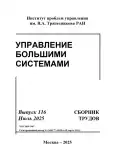The role of the structural properties of local networks in opinion formation
- Авторлар: Cherevichanya N.V.1, Kozitsin I.V.2
-
Мекемелер:
- Moscow Institute of Physics and Technology
- V.A. Trapeznikov Institute of Control Sciences of RAS, Moscow, PhD, Senior Researcher, Moscow Institute of Physics and Technology
- Шығарылым: № 116 (2025)
- Беттер: 116-134
- Бөлім: Networking in control sciences
- URL: https://bakhtiniada.ru/1819-2440/article/view/307002
- ID: 307002
Дәйексөз келтіру
Толық мәтін
Аннотация
Авторлар туралы
Natalya Cherevichanya
Moscow Institute of Physics and Technology
Email: cherevichnaia.nv@phystech.edu
Moscow
Ivan Kozitsin
V.A. Trapeznikov Institute of Control Sciences of RAS, Moscow, PhD, Senior Researcher, Moscow Institute of Physics and Technology
Email: kozisin.ivan@mail.ru
Moscow
Әдебиет тізімі
- ARAL S., WALKER D. Tie strength, embeddedness, and socialinfluence: A large-scale networked experiment // ManagementScience. – 2014. – Vol. 60, No. 6. – P. 1352–1370. – doi: 10.1287/mnsc.2014.1936.
- BURE V., PARILINA E., SEDAKOV A. Consensus insocial networks with heterogeneous agents and two centersof influence // Int. Conf. Stability and Control Processes inMemory of V.I. Zubov (SCP–2015). – IEEE, 2015. – P. 233–236. – doi: 10.1109/SCP.2015.7342113.
- CENTOLA D. The spread of behavior in an online socialnetwork experiment // Science. – 2010. – Vol. 329. – No. 5996. –P. 1194–1197. – doi: 10.1126/science.1185231.
- CLIFFORD P., SUDBURY A. A model for spatial conflict //Biometrika. – 1973. – Vol. 60, No. 3. – P. 581–588. – doi: 10.1093/biomet/60.3.581.
- DEGROOT M.H. Reaching a consensus // Journal of theAmerican Statistical Association. – 1974. – Vol. 69, No. 345. –P. 118–121. – doi: 10.1080/01621459.1974.10480137.
- FLACHE A. et al. Models of social influence: Towards thenext frontiers // Jasss-The Journal of Artificial Societies andSocial Simulation. – 2017. – Vol. 20, No. 4. – P. 2. – doi: 10.18564/jasss.3521.
- FRENCH JR J.R.P. A formal theory of social power //Psychological Review. – 1956. – Vol. 63, No. 3. – P. 181–194. –doi: 10.1037/h0046123.
- GEZHA V.N., KOZITSIN I.V. The effects of individuals’opinion and non-opinion characteristics on the Organization ofInfluence Networks in the online domain // Computers. – 2023. –Vol. 12, No. 6. – P. 116. – doi: 10.3390/computers12060116.
- GONZALEZ-BAILON S., DE DOMENICO M. Bots are lesscentral than verified accounts during contentious politicalevents // Proc. of the National Academy of Sciences. –2021. – Vol. 118, No. 11. – P. e2013443118. – doi: 10.1073/pnas.2013443118.
- HARARY F. A criterion for unanimity in French’s theory ofsocial power // In: D. Cartwright (Ed.) Studies in social power. –1959. – P. 168–192.
- KAIRAM S.R., WANG D.J., LESKOVEC J. The life and deathof online groups: Predicting group growth and longevity // Proc.of the fifth ACM Int. Conf. on Web Search and Data Mining. –2012. – P. 673–682. – doi: 10.1145/2124295.2124374.
- KOEHLER D. The radical online: Individual radicalizationprocesses and the role of the Internet // Journal forDeradicalization. – 2014. – No. 1. – P. 116–134.
- KOZITSIN I.V. et al. Modeling political preferences ofrussian users exemplified by the social network Vkontakte //Mathematical Models and Computer Simulations. – 2020. –Vol. 12. – P. 185–194. – doi: 10.1134/S2070048220020088.
- KOZITSIN I.V. Formal models of opinion formation and theirapplication to real data: evidence from online social networks //The Journal of Mathematical Sociology. – 2022. – Vol. 46,No. 2. – P. 120–147. – doi: 10.1080/0022250X.2020.1835894.
- KOZITSIN I.V. A general framework to link theory andempirics in opinion formation models // Scientific Reports. –2022. – Vol. 12, No. 1. – P. 5543. – doi: 10.1038/s41598-022-09468-3.
- KOZITSIN I.V. Opinion dynamics of online social networkusers: a micro-level analysis // The Journal of MathematicalSociology. – 2023. – Vol. 47, No. 1. – P. 1–41. – doi: 10.1080/0022250X.2021.1956917.
- LIU S. et al. Job Done? New Modeling Challenges After 20Years of Work on Bounded-Confidence Models // JASSS. –2023. – Vol. 26, No. 4. – P. 8.
- PARSEGOV S.E. et al. Novel multidimensional models ofopinion dynamics in social networks // IEEE Trans. onAutomatic Control. – 2016. – Vol. 62, No. 5. – P. 2270–2285. –doi: 10.1109/TAC.2016.2613905.
- PETROV A., AKHREMENKO A., ZHEGLOV S. DualIdentity in Repressive Contexts: An Agent-Based Model ofProtest Dynamics // Social Science Computer Review. –2023. – Vol. 41, No. 6. – P. 2249–2273. – doi: 10.1177/08944393231159953.
- PROSKURNIKOV A.V., TEMPO R. A tutorial on modelingand analysis of dynamic social networks. Part I // AnnualReviews in Control. – 2017. – Vol. 43. – P. 65–79. – doi: 10.1016/j.arcontrol.2017.03.002.
- SNIJDERS T.A.B. Stochastic actor-oriented models fornetwork dynamics // Annual Review of Statistics and itsApplication. – 2017. – Vol. 4, No. 1. – P. 343–363. – doi: 10.1146/annurev-statistics-060116-054035.
- UGANDER J. et al. Structural diversity in social contagion //Proc. of the National Academy of Sciences. – 2012. – Vol. 109,No. 16. – P. 5962–5966. – doi: 10.1073/pnas.1116502109.
- ZHU K., YING L. Information source detection in the SIRmodel: A sample-path-based approach // IEEE/ACM Trans. onNetworking. – 2014. – Vol. 24, No. 1. – P. 408–421. – doi: 10.1109/TNET.2014.2364972.
Қосымша файлдар










